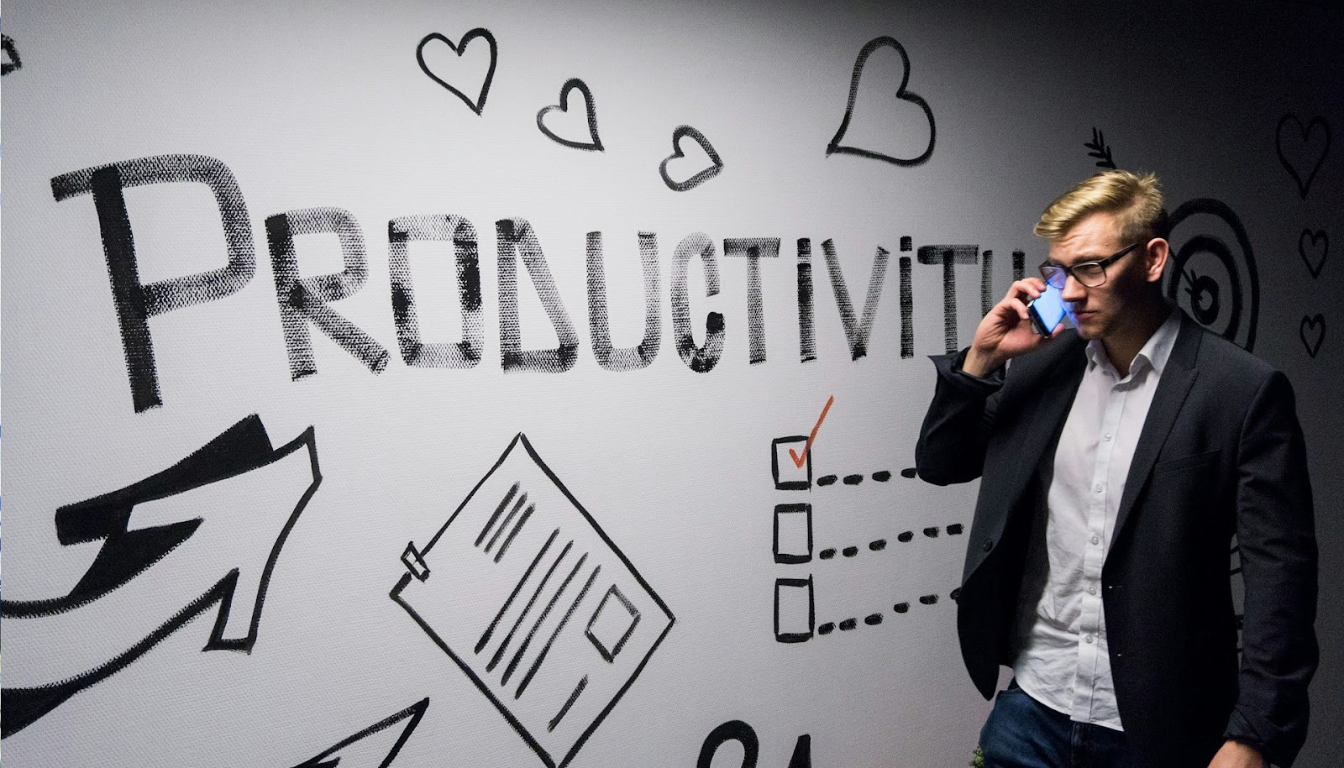The Future of Workplace and Productivity: Trends and Solutions for Success

Looking to increase workplace and productivity? This article covers the key factors that influence productivity and offers practical strategies to enhance efficiency. Discover essential metrics, the role of company culture, and how technology can help. Get actionable tips to create a more productive work environment.
Key Takeaways
- Workplace productivity is a crucial metric that assesses the efficiency of employee output relative to labor hours, highlighting the need for effective productivity measures.
- Key factors such as work environment, company culture, and employee engagement significantly influence workplace productivity and overall employee satisfaction.
- Hybrid work models, supported by modern technology and a focus on work-life balance, can enhance productivity and employee well-being while addressing challenges associated with remote work.
Understanding Workplace Productivity

Workplace productivity is more than just a buzzword; it represents the value each team member brings to the organization as a valuable resource. At its core, it is used to measure productivity by the revenue generated relative to employee labor hours in a given period, typically a quarter. This metric helps organizations understand the efficiency and effectiveness of their workforce, guiding improvements and strategic decisions regarding workers productivity.
Despite the typical 8-hour work hours, the average actual productive time is shockingly around 2 hours and 53 minutes. This gap underscores the importance of addressing productivity challenges, as low productivity can severely impact a company’s overall output and success. Identifying and implementing effective productivity measures is essential for enhancing worker productivity and achieving desirable business outcomes, especially when considering the hours worked.
Productivity metrics are not just numbers; they are vital indicators of how well employees are performing and contributing to the company’s goals. These metrics help determine the value employees add to the organization and can significantly influence business strategies and outcomes. Understanding them is the first step toward creating a more productive business environment.
Key Factors Affecting Employee Productivity
Several key factors influence workplace productivity, each playing a crucial role in shaping employee performance. A productive work environment, characterized by high levels of engagement, motivation, and a positive work culture, is fundamental. Psychological safety at work also significantly impacts productivity levels, as employees who feel safe are more likely to be engaged and motivated.
Happier employees working tend to be more productive, with satisfied workers being about twice as productive as their dissatisfied counterparts. Effective strategies that positively affect productivity can enhance team performance and morale and improve job satisfaction. Ongoing employee training is necessary for adapting to changing industry trends and improving business processes.
Work Environment
The work environment profoundly impacts employee well-being and performance. Key elements defining this environment include:
- Management styles
- Company values
- Culture
- Communication styles
- Leadership
- Trust
Establishing a structured approach to improve productivity can lead to a positive impact on significant enhancements in employee output.
An effective hybrid work environment relies on continuous employee feedback to tailor strategies that boost both productivity and engagement. Offsite meetings can rejuvenate employees by providing a fresh environment, which enhances creativity and perspective. Providing access to training opportunities and resources helps employees in their pursuit of improvement.
These elements help create a supportive and motivating environment, crucial for maximizing productivity. Managers and organizations should build a culture building that promotes trust, open communication, and continuous feedback to foster a productive and engaged workforce.
Company Culture
A strong company culture can significantly enhance employee performance and satisfaction. Delegating tasks empowers team members, fostering a sense of ownership and improving overall team morale. This is particularly important in hybrid workplaces where regular face-to-face interactions are limited.
Offsite gatherings foster team bonding through shared experiences, contributing to a supportive workplace culture. Investing in offsite retreats communicates to employees that their well-being is a priority, enhancing job satisfaction and loyalty. These initiatives lead to lower employee turnover, improved performance, and higher retention rates.
Employee Engagement
Engaged employees show higher levels of motivation and productivity. Higher employee engagement is linked to improved work-life balance, resulting in better overall performance. A supportive work environment fosters greater employee experience engagement and efficiency.
Key strategies for increasing organizational productivity include:
- Regular check-ins and opportunities for feedback
- Gamification
- Building out career growth paths
- Providing constructive feedback to identify growth areas and facilitate employee development.
Maximizing Productivity with Technology

Technology plays a pivotal role in enhancing workplace productivity. Effective communication and collaboration tools are essential for maintaining connectivity among remote team members, which is crucial for productivity. Clear protocols and the use of technology can bridge gaps between remote and on-site employees, ensuring seamless communication.
Modern tools and technology are crucial for maximizing productivity in the workplace, including:
- Cloud-based tools, which increase accessibility and allow employees to work efficiently from various locations, boosting overall productivity.
- Automation tools, which help eliminate repetitive tasks, enabling employees to focus on more creative work and enhancing productivity.
- Communication tools and project management software, which support effective collaboration and organization.
Leveraging these technological advancements helps organizations foster a more productive and engaged workforce. Investing in the right tools and ensuring their effective implementation is vital for achieving higher productivity levels and better business outcomes through generative ai.
Strategies to Improve Workplace Productivity

Implementing strategies that positively influence productivity can significantly enhance overall workplace effectiveness. Individuals who feel challenged, valued, and rewarded for their impact are more productive. Effective delegation can lead to improved efficiency and prevent employee burnout.
Setting clear goals, a manager can effectively manage time and delegate tasks to significantly boost employee productivity. These strategies help create a more focused, motivated, and productive workforce, essential for achieving business success.
Setting Clear Goals
Monitoring employee productivity in hybrid environments can be a challenge, making it important to set clear performance targets and conduct regular check-ins. Setting clear and achievable goals enhances workplace productivity and employee engagement.
Clear communication of expectations and responsibilities ensures successful outcomes and fosters productivity. By defining goals clearly, organizations can create a focused and motivated workforce.
Effective Time Management
Effective time management requires:
- Understanding how time is allocated to tasks to improve overall efficiency.
- Using a short-term to-do list that aligns with overarching goals to help maintain focus on achieving them.
- Setting clear expectations before starting a project to save time and reduce the need for revisions.
Batching similar tasks and smaller tasks minimizes cognitive strain and improves efficiency. Incorporating regular breaks can refresh mental perspective and improve problem-solving capabilities. These time management strategies are essential for maintaining high productivity levels.
Delegation
Delegating tasks offers several benefits:
- Allows leaders to focus on higher-level responsibilities, enhancing overall productivity.
- Prevents burnout by distributing workload effectively.
- Enables employees to concentrate on their core responsibilities, improving efficiency.
Effective delegation not only boosts productivity but also contributes to a more balanced and motivated workforce.
The Role of Hybrid Work in Enhancing Productivity

Key points about hybrid work arrangements include:
- Approximately 58% of employees experience an increase in productivity.
- About 63% of employees in hybrid roles report feeling more empowered.
- Hybrid work supports creativity and innovation, especially in jobs that benefit from both independent and collaborative tasks.
The hybrid work model balances remote and hybrid work and in-office work, enhancing productivity and job satisfaction. Effective communication tools are crucial for maintaining productivity in hybrid working environments. Strategic planning and modern tools are key to successfully implementing a remote work model.
Maintaining work-life balance is crucial for hybrid workers to ensure productivity and prevent burnout. Flexibility in work schedules, including a hybrid schedule, allows employees to recharge, which can enhance their productivity upon returning to work. High levels of workplace productivity in a hybrid work environment demand intentional connection and alignment.
Overcoming Challenges in Hybrid Work
Investing in robust strategies and prioritizing employee needs is crucial for companies to thrive in the era of hybrid work, as noted by Nicholas Bloom. The loss of daily commuters due to long commutes and hybrid work has significantly impacted businesses that rely on office workers.
Addressing hybrid work challenges is crucial for maintaining productivity and employee well-being. By addressing the challenges associated with hybrid work, companies can ensure sustained productivity and enhance employee satisfaction.
The Importance of Work-Life Balance

Supporting work-life balance is linked to better mental and physical health among employees. Employees who achieve a balance between their work and personal lives are generally more satisfied and demonstrate higher productivity.
A supportive work environment that prioritizes work-life balance can significantly enhance morale among employees. Establishing work-life support can be an effective strategy for promoting organizational diversity. A healthy work-life balance is vital for boosting productivity and enhancing employee well-being.
Case Study: How Offsite Boosts Productivity
Offsite simplifies corporate retreat planning by providing a platform to discover venues and vendors, submit booking requests, and receive proposals. Offsite offers end-to-end retreat planning services at a flat, per-person rate, including expert guidance at no additional cost.
A distraction-free venue helps employees engage more fully in discussions and training, resulting in meaningful productivity. Offsite helps teams maximize hybrid work productivity by designing impactful offsite experiences that strengthen collaboration, boost morale, and drive focus, enabling deep work.
These gatherings ensure that time spent together translates into better outcomes when teams are apart. The Offsite team has decades of collective experience in travel, hospitality, and corporate retreat planning.
Tips for Personal Productivity
Techniques to improve focus and productivity include:
- Blocking all alerts to minimize distractions and stay focused on tasks.
- Practicing saying ‘no’ to establish boundaries and enhance focus on important tasks.
- Using techniques like the Pomodoro Technique to encourage regular breaks, leading to increased productivity.
Weekly block planning helps individuals prioritize key tasks and manage time effectively. A consistent morning routine can significantly improve daily productivity. Positive self-talk enhances mental energy and improves productivity.
Fostering Continuous Improvement
A culture of ongoing development within a company promotes continual learning and enhances productivity. Business leaders should exemplify commitment to continuous improvement by actively participating in training and development initiatives that build knowledge through research, providing examples of best practices.
Enhanced employee commitment can significantly boost overall productivity. Continuous improvement initiatives encourage innovation and ensure that employees remain engaged and motivated.
Summary
In conclusion, workplace productivity is influenced by various factors, including the work environment, company culture, and employee engagement. Leveraging technology and implementing effective strategies like setting clear goals, managing time effectively, and delegating tasks are crucial for enhancing productivity. Hybrid work models offer flexibility and can boost productivity when managed well. Prioritizing work-life balance and fostering continuous improvement are essential for long-term success. By adopting these practices, organizations can create a more productive, motivated, and engaged workforce.
FAQs
- What is the average actual productive time in an 8-hour workday?
The average actual productive time in an 8-hour workday is about 2 hours and 53 minutes. This highlights the importance of maximizing efficiency during working hours.
- How does Offsite help in corporate retreat planning?
Offsite streamlines corporate retreat planning by providing a user-friendly platform for discovering venues and vendors, submitting booking requests, and receiving proposals efficiently. This ensures a more organized and effective planning process for your team.
- What are the benefits of hybrid work?
Hybrid work enhances creativity and innovation while promoting work-life balance, ultimately resulting in higher productivity and job satisfaction.
- How can employee engagement be improved?
Improving employee engagement can be achieved through regular check-ins, facilitating feedback opportunities, incorporating gamification, and establishing clear career growth paths. These strategies help create a more connected and motivated workforce.
You may also like
Unique spaces for your next offsite
Find distinctive venues for your upcoming corporate retreat.
Stay Updated with Our Insights
Get exclusive content and valuable updates directly to you.







